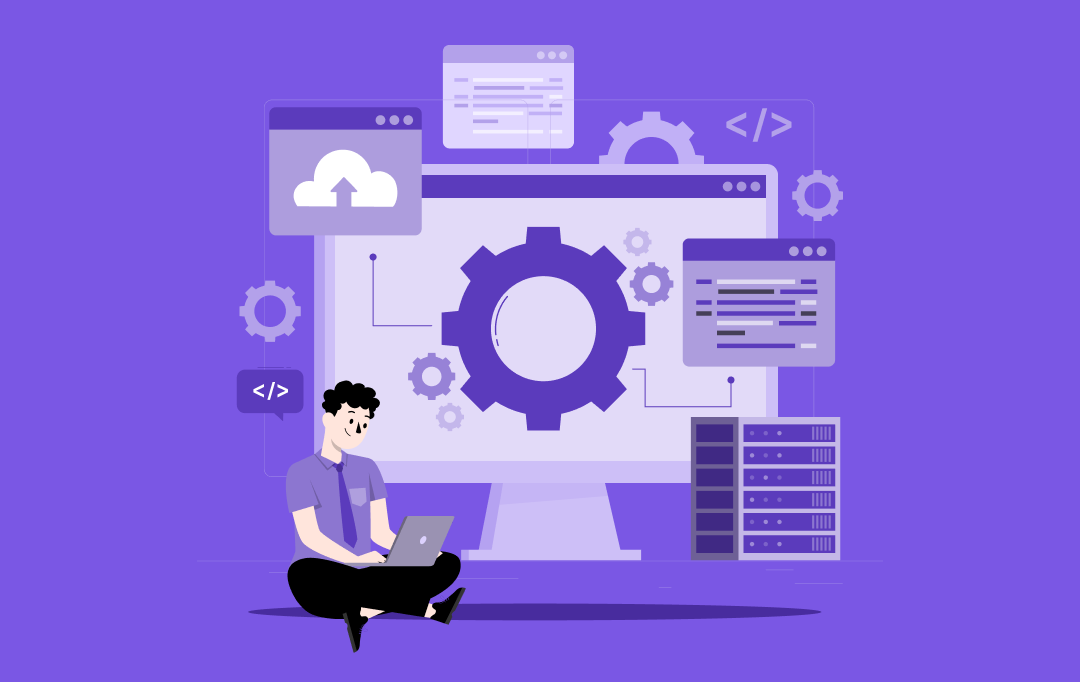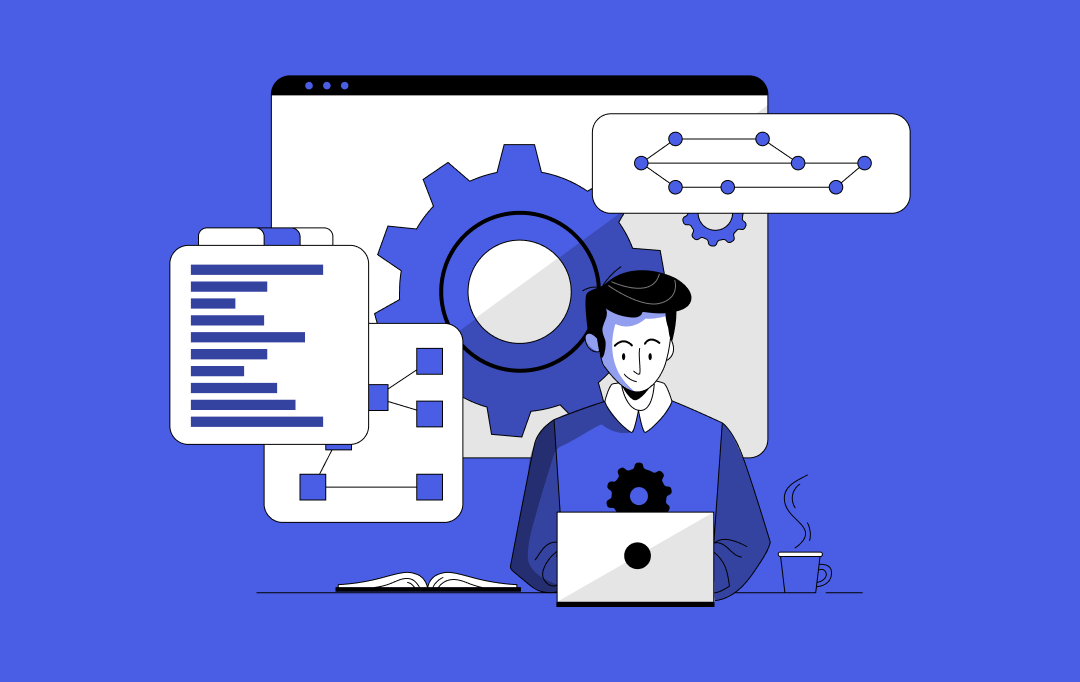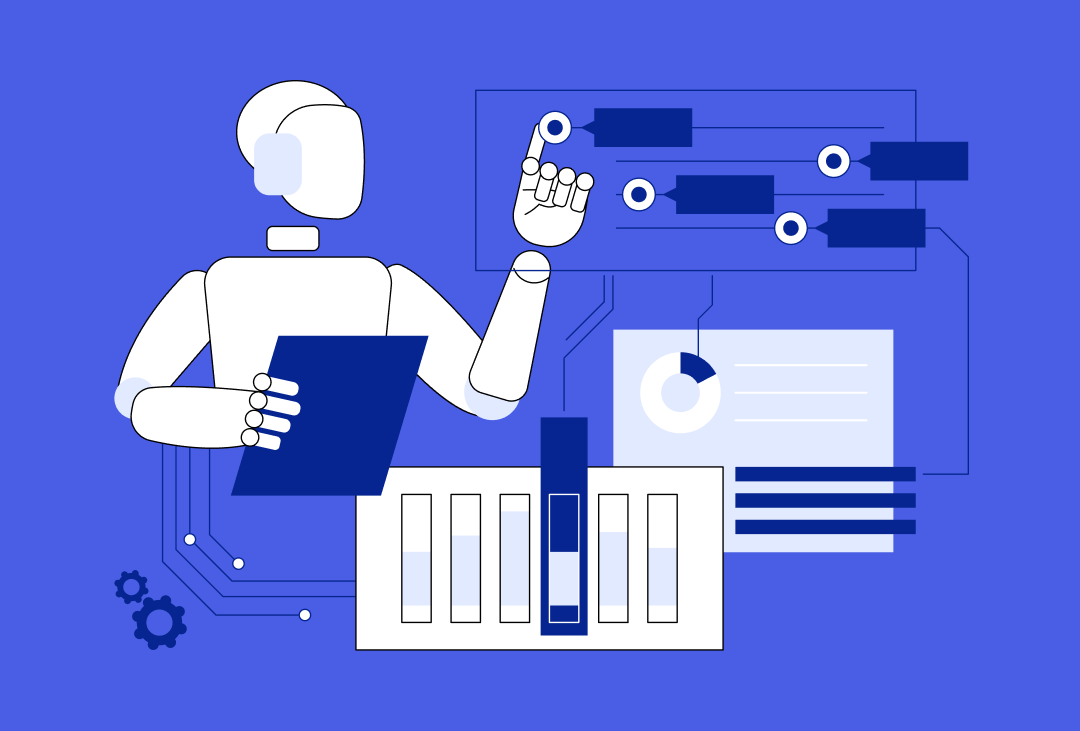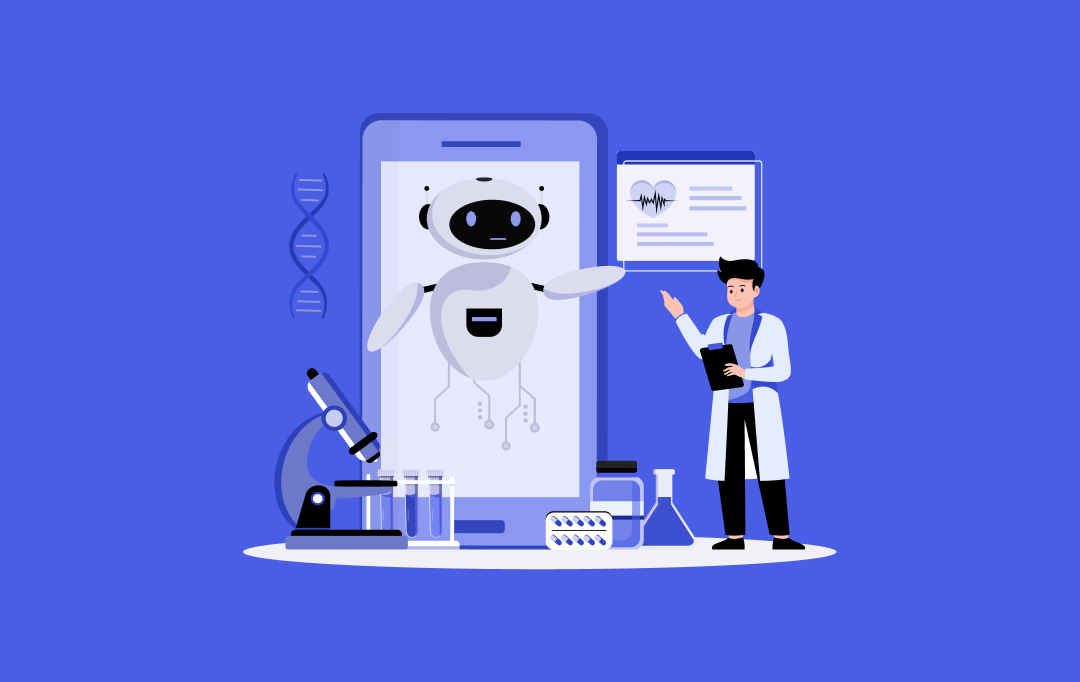What if future product design is not solely driven by human creativity? What if artificial intelligence can help users in a new era of design innovation, accuracy, and productivity?
This appears to be a reality today, as artificial intelligence in product development is gradually transforming how goods are imagined, developed, and brought to life. AI is truly at the center of digital product design, refining everything from original concepts to user-centered prototypes.
By incorporating AI into the product design process, businesses can boost creativity, enhance decision-making, and accelerate time to market. The advantages are evident, whether using AI-driven product design or intelligent prototyping.
A survey by Adobe recently reported that 62% of UX designers use AI to automate repetitive tasks that enhance productivity. That is more than just a transition; it can be important for an organization. AI in product development and design provides more than just opportunities to cut down on workflow, inspire creativity, and create tailored user experiences that stand out.
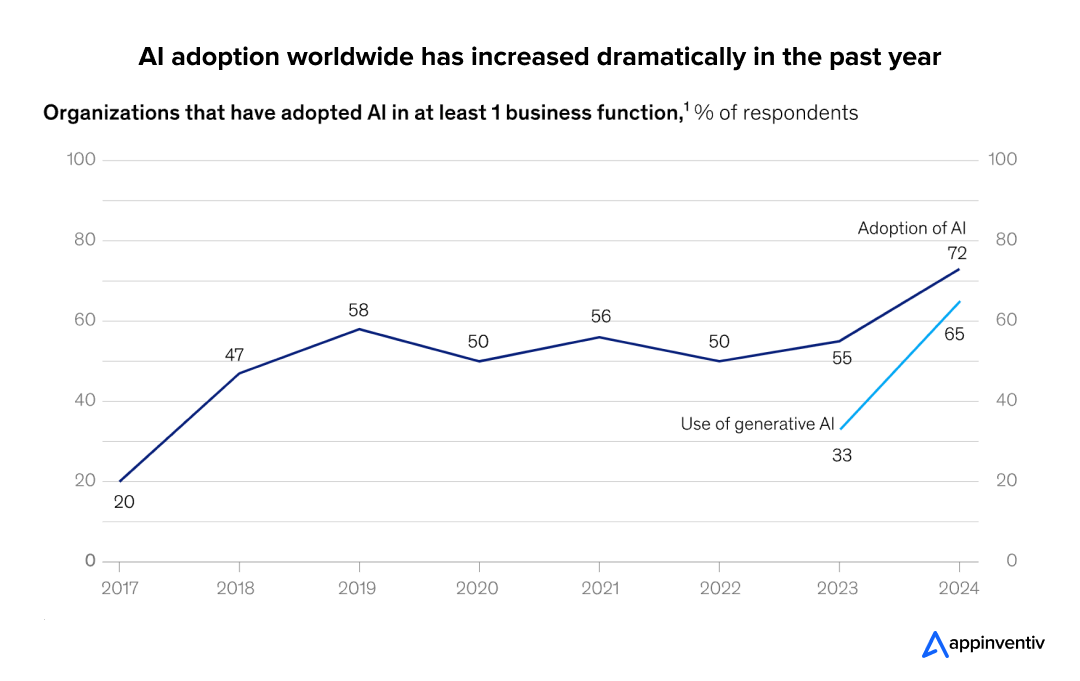
According to McKinsey, 65% of respondents reported that their organizations regularly use gen AI, nearly doubling the percentage from the previous year. The survey also found that adoption had jumped to 72%.
This article examines 10 ways AI transforms conventional product design approaches and emphasizes how AI-driven digital product design influences the future. Let’s find out how AI is changing product design.
AI in Digital Product Design
AI in product design involves using artificial intelligence within the design process to enhance efficiency, creativity, and user experience. AI streamlines repetitive activities like layout creation, color selection, and typography modifications. Generative AI for product design creates innovative design solutions through data analysis and the creation of various design options according to set parameters.
AI tools boost decision-making by providing data-driven insights regarding user preferences and behaviors. Examples of AI in digital product design include tools like Figma and Adobe XD, which feature AI-enhanced capabilities such as predictive recommendations and automated processes.
The impact of AI on product design is revolutionary. It enhances workflows and shortens design durations. In summary, the advantages of utilizing artificial intelligence in product design encompass quicker iterations, enhanced creativity, and superior user-focused digital products.
How is AI Used in Product Design?
AI is slowly changing the product design process by increasing efficiency, creativity, and personalization. Here’s an overview of AI’s usage:
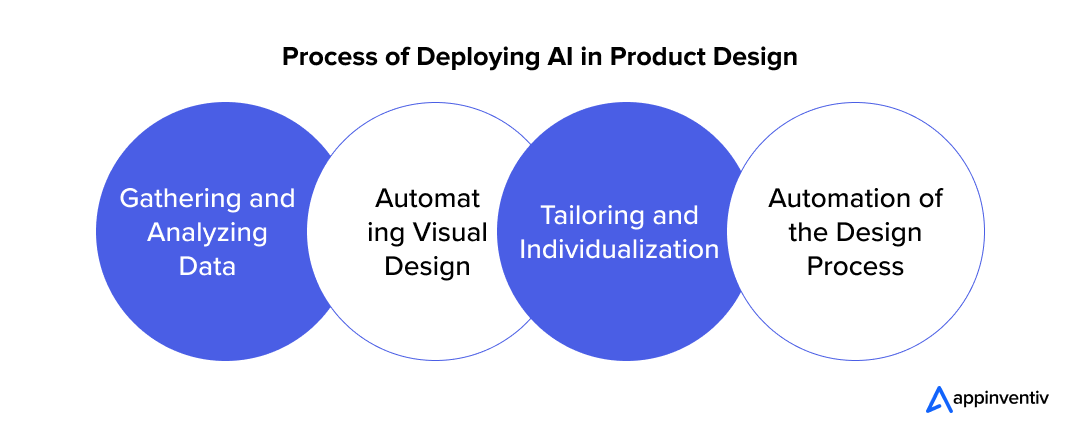
Gathering and Analyzing Data
AI-driven tools assist designers in gathering and analyzing data from multiple sources, such as user feedback, surveys, and social media. They recognize patterns and trends from which designers can selectively choose for design and user experience improvements. Several machine learning algorithms like Google Analytics provide precise and deep insights into data interpretation, helping save the amount of time to analyze the data.
Automating Visual Design
AI streamlines repetitive design activities, like adjusting sizes or correcting the colors of images, allowing designers to concentrate on more innovative elements. Features such as Adobe’s stitching tool enhance combining images, reducing time and mistakes. AI can also automatically produce layouts and prototypes, accelerating the design process while guaranteeing high-quality results.
Tailoring and Individualization
AI tools evaluate user information to provide tailored experiences. They predict user requirements and preferences and modify designs to deliver tailored solutions. AI-powered personalization systems can customize product designs to meet individual user actions, improving user satisfaction and involvement.
Automation of the Design Process
AI can automate significant parts of the design process, particularly in gaming, architecture, and advertising. AI can create novel designs and adjust to intricate, tailored needs by training models to understand design principles from selected datasets, greatly minimizing time and resource expenditure.
Through these applications of AI in digital product design, AI is revolutionizing product design and enhancing processes to be more effective and focused on the user.
How to Use AI for Product Design: 10 Effective Use-Cases
AI is revolutionizing conventional digital product design methods by offering new solutions that improve creativity, efficiency, and user experience. AI transforms how designers engage with their tasks by utilizing automation, customization, predictive analysis, and instantaneous enhancements.
Here are 10 essential areas in which AI is significantly impacting design processes.
Generative AI for Product Design
Generative AI utilizes sophisticated algorithms to develop creative designs by examining extensive datasets and producing results based on defined criteria. It has evolved into a crucial resource for investigating inventive options and speeding up the design procedure.
- Utilization of Generative AI Tools: Generative AI tools such as Adobe Firefly and Runway ML streamline the ideation process by producing numerous design concepts. These resources enable designers to explore different aesthetics and functions without beginning anew.
For example, generative AI can create variations of an image, suggest layout alternatives, refine the concepts, or develop entirely new artistic elements and test them at different parameters based on user preferences. This accelerates the design process and encourages creative experimentation, empowering designers to explore and refine innovative ideas rapidly.
- Streamlining Creative Processes: AI automates repetitive tasks like creating design variations, resizing assets, and managing workflows. It significantly reduces manual effort and time. Designers can quickly iterate on ideas and access personalized suggestions by integrating generative design systems or smart asset libraries. It allows them to allocate more time to strategic elements, like enhancing concepts and confirming alignment with brand objectives.
AI in Digital Product Design for Customization
Personalization has emerged as a key element of contemporary digital experiences, and AI plays a crucial role in providing customized designs. By examining user actions, AI-powered systems modify interfaces to cater to individual needs and preferences.
- Tailored User Experiences: AI in digital product design utilizes behavioral information to develop responsive interfaces. For instance, online retail sites employ AI algorithms to suggest products that match personal user preferences, enhancing engagement and satisfaction.
- AI-Powered Adaptive Designs: AI continuously modifies layouts, color palettes, and content display according to user engagement trends. This guarantees a smooth and intuitive experience for various user groups.
AI-Enhanced Prototyping
AI-aided prototyping accelerates the development of preliminary product models, enhancing the design process’s efficiency and minimizing mistakes. It allows designers to visualize ideas and refine them accurately and rapidly.
- Speeding Up Prototyping with Accuracy: Software such as Autodesk Fusion 360 uses AI to streamline intricate processes like 3modellingng. This guarantees uniformity and accuracy while greatly decreasing the time needed to develop prototypes.
- Advantages in Testing Phases: AI enhances testing by mimicking user interactions and discovering possible problems early. This leads to stronger prototypes and a more seamless shift to production.
Predictive Analysis in Design Choices
Predictive analytics utilizes AI to examine historical and real-time data, assisting designers in making well-informed choices. AI guarantees that designs stay significant and influential by forecasting market trends and user requirements.
- Grasping Market Trends: Predictive analytics tools reveal developing trends and changes in consumer preferences, enabling designers to maintain an advantage over competitors.
- AI Insights for Design Decisions: AI offers data-based insights on which features and elements are expected to connect with users. This aids in prioritizing design initiatives for optimal impact.
Automating Repetitive Tasks
AI is proficient at automating monotonous tasks, including adjusting image sizes, formatting layouts, and creating templates. This not only conserves time but also reduces human mistakes.
- Accelerated Results through Automation: Tools like Canva and Figma streamline repetitive tasks, promoting quicker project finalization and enhanced workflow productivity.
- Effect on Innovation and Time Management: By handling monotonous tasks, AI enables designers to focus on brainstorming and originality, promoting a more imaginative atmosphere.
AI and Accessibility in Product Development
AI in design helps handle accessibility issues and promote inclusivity in digital products. AI-powered tools fill gaps for individuals with disabilities by offering customized solutions.
- Creating inclusive products using AI tools: AI tools, like Microsoft Seeing AI and Google’s accessibility checker, assist designers in developing interfaces that support users with disabilities. These instruments recommend enhancements in navigation, contrast, and readability.
- Proactively tackling accessibility gaps: By integrating AI into the product design workflow, designers can actively discover and resolve accessibility challenges, fostering a more inclusive user experience.
Enhanced Workflows via AI Integration
Incorporating AI in design processes boosts teamwork, increases productivity, and maintains group uniformity. This is especially important in significant projects involving numerous stakeholders.
- Optimizing Design Workflows: AI platforms such as Monday.com and Asana facilitate task prioritization and resource distribution, allowing teams to effortlessly handle intricate projects.
- Practical Uses: Businesses use AI-driven digital product design services to synchronize teams, monitor progress, and ensure smooth implementation. AI-powered workflow systems, for instance, facilitate immediate updates and the exchange of feedback.
Promoting Sustainability with AI-Driven Digital Product Design
Sustainability has emerged as a central theme in contemporary design processes, with AI significantly contributing to advancing environmentally friendly practices. By enhancing resource utilization, AI reduces waste, which is crucial in sustainable production initiatives.
- Encouraging Sustainable Manufacturing: AI helps pinpoint inefficiencies in production processes, enabling decreases in material waste and energy use. These solutions aid in prioritizing sustainability while guaranteeing top-quality results and minimizing the environmental effects of design procedures.
- Advancing Sustainable Production: AI helps pinpoint inefficiencies in manufacturing, enabling cuts in material waste and energy use. These solutions assist in prioritizing sustainability while guaranteeing top-quality results and minimizing the ecological footprint of design procedures.
Collaboration Enhanced by AI
AI improves team collaboration through better communication, feedback consolidation, and real-time updates, resulting in more integrated and effective teamwork.
- Enhancing Team Collaboration: AI-driven platforms like Slack and Miro make teamwork easier by optimizing communication and centralizing all project feedback and conversations.
- Illustration of AI-Powered Feedback Mechanisms: AI technologies offer immediate, data-based recommendations, allowing groups to enhance designs rapidly. These systems shorten review cycles and improve productivity, guaranteeing prompt delivery of top-notch designs.
Enhancing Aesthetics through AI
AI transforms design aesthetics by offering innovative, creative opportunities that push against conventional limits. Generative AI tools introduce creative methods to visual design, providing designers with expanded opportunities.
- Expanding Creative Limits: Generative AI tools such as DALL-E and Stable Diffusion enable designers to explore original and innovative visual ideas, broadening the horizons of creative design.
- The function of AI in Design Aesthetics: AI tracks worldwide design trends and recommends contemporary layouts, color schemes, and styles. By incorporating AI, designers can maintain a competitive edge and provide innovative products that attract a broad audience.
Real-world Examples of Using AI for Product Design
AI is progressively utilized in product design within multiple sectors, boosting creativity, efficiency, and customization. Here are several practical examples:
Nike’s HyperAdapt Sneakers
Nike incorporates AI in creating their groundbreaking HyperAdapt footwear, which includes self-lacing features. By integrating machine learning algorithms, Nike’s design team could enhance the shoe’s fit according to users’ movements. Artificial intelligence in product design was essential for developing a product tailored to personal requirements, boosting performance and comfort while highlighting the benefits of AI in product design, such as customization and enhanced usability.
BMW’s Manufacturing Powered by AI
BMW utilizes AI during the development of its cars, especially in the production phase. By employing AI in product design, they enhance components and boost production efficiency, greatly minimizing waste and improving precision.
The incorporation of AI has enabled BMW to improve customer customization, showcasing how artificial intelligence in product design can enhance manufacturing processes and adapt products to consumer needs.
Autodesk’s Design Generation
Autodesk utilizes generative AI in its product design software, assisting engineers in crafting optimized structures for diverse industries. Generative AI product design examines design options according to specified criteria, improving efficiency. Combining AI and product design has demonstrated its importance in minimizing material waste and developing lighter, more affordable solutions.
Cove.Tool for Eco-Friendly Architecture
Cove uses AI in digital product design to improve building designs through sustainable material selections and energy-saving attributes. By using AI for product design, designers can streamline energy modeling and enhance designs to reduce environmental impact, highlighting the benefits of using artificial intelligence in product design within resource management.
Benefits of Using AI in Product Design
Artificial Intelligence (AI) has transformed the product design process, allowing designers and companies to develop inventive, effective, and user-focused products. Here are several important advantages of incorporating AI into product design:
Improved Design Effectiveness
AI greatly enhances design efficiency by automating tedious tasks and streamlining workflows. Tools powered by AI, like sketch generators and design assistants, simplify the workflow, enabling designers to concentrate on more imaginative elements. This method aids in employing AI for product design by swiftly producing various design ideas, minimizing the time dedicated to initial drafts, and enhancing the overall efficiency of the design process.
Enhanced Personalization
AI assists in generating customized product designs by examining extensive user data. This allows designers to customize products according to particular customer preferences and requirements, enhancing user interaction. The role of AI in product design is as its algorithms modify product features and layouts according to user demographics, facilitating highly tailored solutions in digital product design through AI.
Quicker Prototype Development and Evaluation
Generative AI product design speeds up prototyping by rapidly producing design options from initial inputs. This considerably reduces the duration of the product development cycle. AI tools enable fast testing by mimicking real-world performance and user engagement, optimizing the iteration process. This ability is a crucial aspect of AI in product design, facilitating swift validation and enhancement of design ideas.
Enhanced Innovation and Creativity
Generative AI product design enhances creativity by proposing original design ideas beyond conventional limits. AI algorithms can examine worldwide design trends and suggest innovative layouts, color combinations, and patterns that traditional methods may not achieve.
This motivates designers to investigate new creative paths and incorporate innovative solutions into their product designs. AI tools’ advantages in product design are clear: They enhance creative options, helping designs remain competitive.
Key Challenges of Integrating AI in Product Design
AI product design has the potential to transform processes, yet it presents its unique challenges. Here are several main challenges:
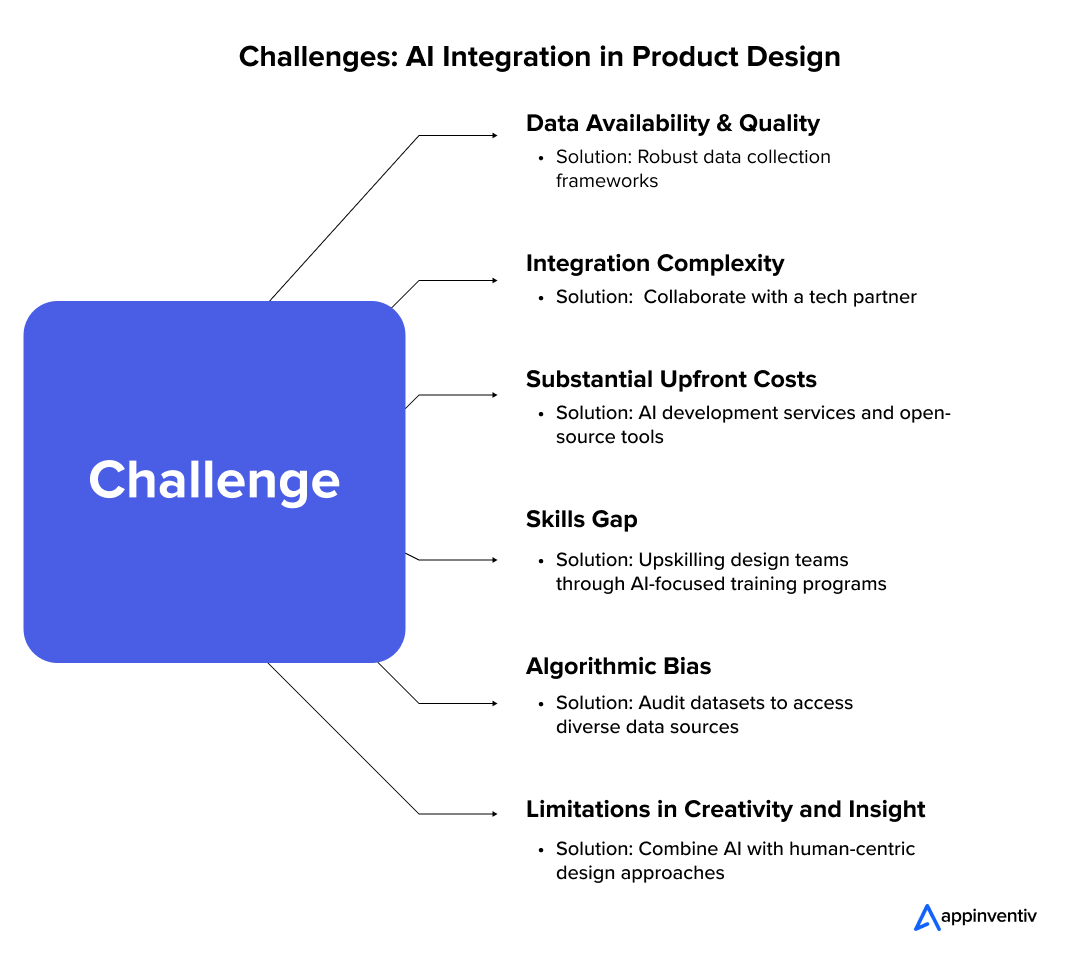
Data Availability and Quality
Challenge: AI models depend on extensive, high-quality data to deliver precise insights. In product design, collecting and analyzing such data can be challenging, as inadequate or insufficient data might result in erroneous design choices.
Solution: Implement robust data collection frameworks and use data augmentation techniques to bridge data gaps and enhance the quality of collected data.
Integration Complexity
Challenge: Incorporating AI into current design processes can be difficult. It necessitates verifying compatibility with existing tools, systems, and infrastructure, potentially requiring substantial technical knowledge to prevent disruptions and ensure seamless integration.
Solution: Collaborate with a reputed AI integration consulting partner to streamline integration and mitigate disruptions, ensuring a smoother transition to AI-driven processes.
Substantial Upfront Costs
Challenge: Creating AI solutions for product design requires considerable financial resources and a time commitment. This encompasses expenses related to data gathering, model training, and infrastructure establishment, which might be challenging for smaller companies to justify without a distinct ROI.
Solution: Start with scalable AI solutions and open-source tools to reduce costs. Opting for initial integration through pilot projects can help justify further investments by showcasing potential ROI.
Skills Gap
Challenge: One Challenge of integrating AI in product design is that it requires proficiency in data science, machine learning, and AI-specific tools. Numerous design teams lack these specific skills, complicating the adoption of AI without the need for training investments or recruiting new talent.
Solution: Invest in upskilling your design teams through training programs focused on AI and machine learning. Alternatively, collaborate with AI specialists or hire external consultants to fill immediate skill gaps.
Algorithmic Bias
Challenge: AI models developed using biased datasets may reinforce biases. In product design, this may result in products that inadvertently benefit specific groups while excluding others, creating ethical and market challenges.
Solution: Regularly audit datasets for biases and employ diverse data sources during model training. Use explainable AI to ensure equitable outcomes and mitigate ethical risks in product design.
Limitations in Creativity and Insight
Challenge: Although AI can enhance designs through data analysis, it still does not possess the creativity and insight human designers offer. Integrating AI’s analytical capabilities with human creativity is essential for effective product design.
Solution: Combine AI tools with human-centric design approaches to automate repetitive tasks while leaving creative direction to designers. Encourage collaboration between AI outputs and human intuition for balanced innovation.
By tackling these obstacles, businesses can tap into the complete capabilities of AI in product development.
Future Trends in AI-Driven Product Design
The future of AI-powered product design is poised to revolutionize how products are imagined, created, and improved. Here are key trends to look for:
Automation of Design Work
In the coming years, AI in product design will progressively take over tasks such as prototyping, layout creation, and material choice. Utilizing AI enables designers to concentrate more on creativity and innovation, as AI manages monotonous tasks. This will accelerate development cycles and minimize human mistakes in the design process.
Improved Customization
Artificial intelligence in product design will significantly contribute to the development of customized experiences. AI will examine user habits and choices to create tailored product designs. Through AI-driven digital product design, designers can create customized offerings to meet individual requirements, boosting customer satisfaction and involvement.
AI Generative for Innovation
The design of generative AI products will keep expanding creative limits by proposing distinctive design ideas that could be difficult to realize with conventional techniques. This will inspire creative product designs, enabling designers to explore new styles, formats, and features. Utilizing generative AI for product design will become an essential competency for upcoming designers.
Smart Design and Effectiveness
AI boosts efficiency in product design by maximizing resource utilization and enhancing design precision. Its advantages result in more intelligent, efficient products, guaranteeing a smooth and productive design process.
Integration of AI and AR
In the future, AI and product design will be integrated with augmented reality (AR) tools, enabling designers to visualize and test product designs instantaneously, enhancing decision-making and minimizing mistakes.
Unlock the Future of AI in Product Design with Appinventiv
Appinventiv, a top artificial intelligence development company, focuses on incorporating AI-powered tools into product design. We assist companies in developing creative, effective, and sustainable products. Our expertise lies in seamlessly integrating artificial intelligence into product design, which enables designers to automate mundane tasks and allows them to concentrate on innovation and creativity.
Integrating AI in product design also enables businesses to innovate faster, minimize waste, and enhance efficiency. Our team of 1600+ tech experts specializes in developing AI-driven tools and strategies that redefine the creative process. From implementing generative AI for ideation to building intelligent systems for real-time optimization, we empower businesses to turn concepts into market-ready products.
With a proven track record of delivering over 3,000 successful projects for different industries, including retail, manufacturing, and healthcare, Appinventiv’s AI development services help businesses elevate design workflows while ensuring measurable outcomes.
The clients’ testimonials from our satisfied clientele speak volumes about the quality of our work. Their pleasant experiences showcase us regarding respecting timelines, going beyond expected performance, and deploying high-performing software.
Additionally, our digital product design services using AI can result in more tailored and user-focused products while facilitating speedy development phases and enhancing precision in production. Combining AI and product design allows organizations to remain competitive, improve product quality, and lower expenses.
As AI increasingly influences the future of design, businesses must embrace these technologies to stay competitive. Let’s collaborate today to transform your design workflow.
FAQs
Q. How do we use generative AI in product design?
A. Here are 10 essential areas in which AI is used in product design:
- Generative AI for Product Design
- AI in Digital Product Design for Customization
- AI-Enhanced Prototyping
- Predictive Analysis in Design Choices
- Automating Repetitive Tasks
- AI and Accessibility in Product Development
- Enhanced Workflows via AI Integration
- Promoting Sustainability with AI-Driven Digital Product Design
- Collaboration Enhanced by AI
- Enhancing Aesthetics through AI
Q. What is the cost of integrating AI in product design?
A. The cost of integrating AI into product design typically ranges between $30,000 and $300,000. However, this is just a rough estimate. To get an accurate idea of the cost, share your project idea with us and receive a detailed quotation tailored to your needs.
Q. What are the benefits of AI in digital product design?
A. Here are some of the most common benefits of using AI in product design
- Improved Design Effectiveness
- Enhanced Personalization
- Quicker Prototype Development and Evaluation
- Enhanced Innovation and Creativity
Product Development & Engineering
IT Managed & Outsourcing
Consulting Services
Data Services
Didn't find what you're looking for? Let us know your needs, and we'll tailor a solution just for you.




